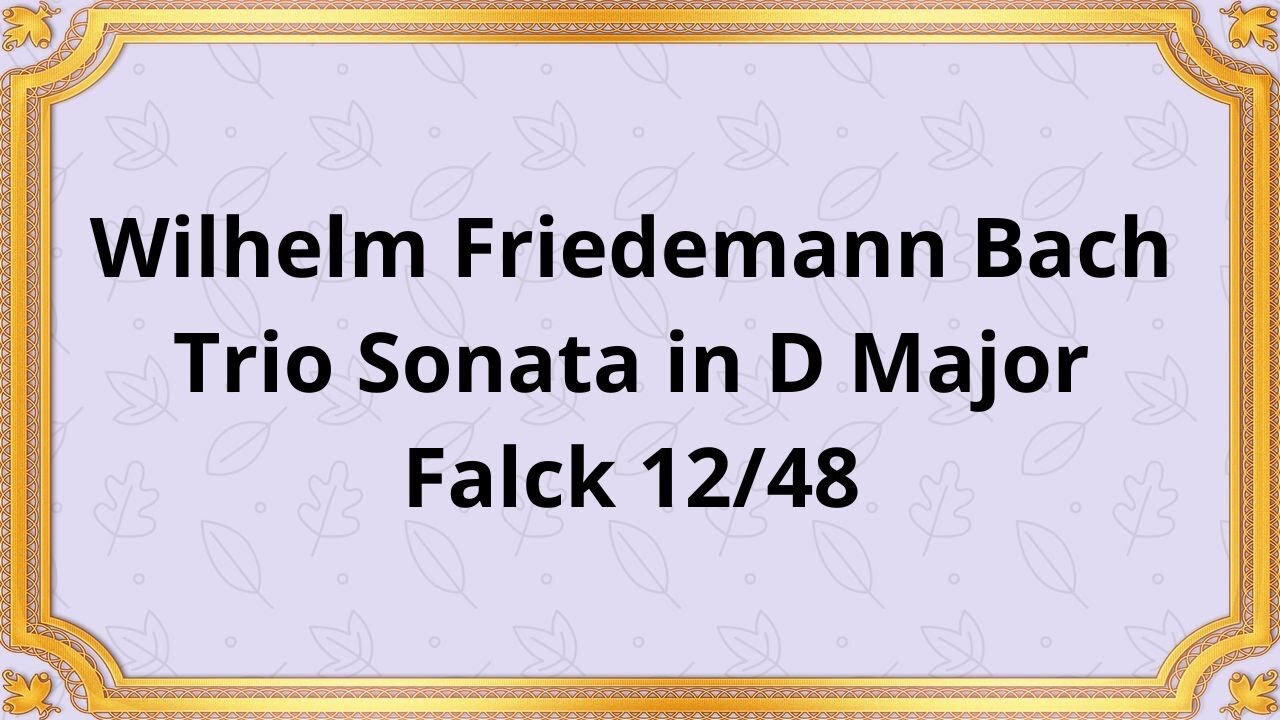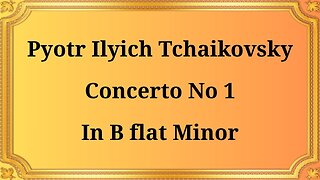Premium Only Content

Wilhelm Friedemann Bach Trio Sonata in D Major, Falck 12/48
#WilhelmFriedemannBach #TrioSonata #DMajor #Falck1248 #ClassicalMusic #MusicalComposition #BaroqueMusic #MusicHistory #MusicAppreciation #ChamberMusic
Gerhard REHM & Eberhart DASCHLER, Flutes
Holger RUCK TESCHLER, Bassoon
Friedrich DOLD, Harpsichord
The world of classical music is adorned with sublime compositions that have stood the test of time. One such masterpiece is the Trio Sonata in D Major, Falck 12/48 by Wilhelm Friedemann Bach. This remarkable piece showcases the brilliance of Bach's musical genius and offers a captivating journey through harmonies and melodies.
Wilhelm Friedemann Bach, the eldest son of the renowned Johann Sebastian Bach, was a prolific composer during the Baroque era. The Trio Sonata in D Major, Falck 12/48 was likely composed in the early 1750s. This period was marked by a transition from the Baroque style to the emerging Classical style, and this composition reflects a fusion of both.
The Trio Sonata in D Major, Falck 12/48 is composed for three instruments: two violins and basso continuo. It consists of four movements, namely Allegro, Andante, Menuetto, and Presto, following the traditional sonata da chiesa structure.
The Allegro movement sets the tone with its energetic and lively character. The intertwining melodies of the violins create a sense of playful dialogue, while the basso continuo provides a solid foundation.
The Andante movement offers a contrasting mood, characterized by its serene and introspective nature. The delicate melodies of the violins weave together, evoking a sense of tranquility and emotional depth.
The Menuetto, a dance-like movement, brings a touch of elegance and grace to the composition. The rhythmic interplay between the instruments adds a lively and spirited element to the piece.
The final movement, Presto, showcases Bach's virtuosity and technical prowess. It is a fast-paced and exhilarating movement that demands precision and agility from the performers.
The Trio Sonata in D Major, Falck 12/48 exhibits a wide range of emotions throughout its movements. From the exuberance and joy of the Allegro to the introspection and serenity of the Andante, listeners are taken on an emotional journey. The Menuetto adds a sense of lightness and celebration, while the Presto leaves a lasting impression with its spirited and invigorating energy.
Conclusion:
The Trio Sonata in D Major, Falck 12/48 by Wilhelm Friedemann Bach is a testament to the enduring beauty and complexity of classical music. Its historical significance, structural elements, and emotional impact make it a captivating piece that continues to enrapture audiences to this day. Whether you are an avid classical music enthusiast or a newcomer to the genre, immersing yourself in the harmonies of this composition is an experience that is sure to leave a lasting impression.
You have the opportunity to support the channel:
https://destream.net/live/RadSiarAl/donate
https://www.buymeacoffee.com/6355radsiaral
-
 31:06
31:06
Classical music_Music Inspiration
1 month agoPyotr Ilyich Tchaikovsky Piano Concerto No. 1 in B-flat minor
571 -

Dear America
2 hours agoTrump CALLS OUT PFIZER!! We Were Always Right…
82.2K57 -
 LIVE
LIVE
Badlands Media
8 hours agoBadlands Daily: September 2, 2025
4,236 watching -
 LIVE
LIVE
Matt Kohrs
12 hours agoMarket Open: September Stock Market CRASH?! || The Top Live Trading Show
631 watching -
 29:30
29:30
Rethinking the Dollar
42 minutes agoTuesday Morning Check-In: Let's Talk...
1.58K1 -
 8:05
8:05
Buddy Brown
4 days ago $1.16 earnedMinneapolis Mayor's QUOTE Comes Back to HAUNT HIM! | Buddy Brown
7754 -
 45:29
45:29
Randi Hipper
1 hour agoPRESIDENTIAL FAMILY CRYPTO PROJECT PLUMMETS AS BITCOIN BREAKS OUT
1.17K -
 LIVE
LIVE
GritsGG
2 hours agoRumble Customs! 3515 Ws! 🫡!
158 watching -
 LIVE
LIVE
Wendy Bell Radio
6 hours agoThe Party Of Workers
7,705 watching -
 LIVE
LIVE
LFA TV
4 hours agoLFA TV ALL DAY STREAM - TUESDAY 9/2/25
4,777 watching